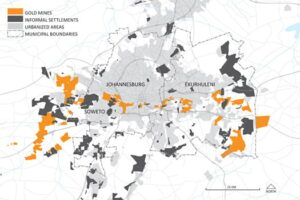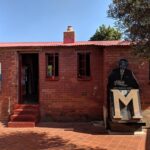I am back in Jozi (one of the abbreviations for Johannesburg) nearly a year later, and it’s probably a good thing I’ve been here before; after 10,000 miles in the air, total of 30 hours, I’m lucky I know where I’m at right now.
I got here around 9 am Jozi time, which is about 8 hours earlier than your time, and rushed to hear the end of our first speaker. Fortunately, we did mostly what we did last year before I left—and fortunately, the visit to the Apartheid museum and the township (read ghetto) of Soweto (short for South West Township) is at least as moving the second time as the first.
Jozi itself is a sprawling city, erected on the largest gold mine in the world (the Witwatersrand), that is the business capital of the Republic of South Africa. In the interior, Jozi acquired population when gold was found here in  1886, a discovery that transformed the Transvaal (a state set up by the Boers, descendants of the original Dutch settlers who clashed with the British, who had seized the Cape Colony to keep it from the French during the Napoleonic Wars) back eventually into a British colony that in 1906 became the Union of South Africa. Population is somewhere around 10-12 million, with townships scattered around gated communities, including Sandton, the financial capital, which is where we are staying.
1886, a discovery that transformed the Transvaal (a state set up by the Boers, descendants of the original Dutch settlers who clashed with the British, who had seized the Cape Colony to keep it from the French during the Napoleonic Wars) back eventually into a British colony that in 1906 became the Union of South Africa. Population is somewhere around 10-12 million, with townships scattered around gated communities, including Sandton, the financial capital, which is where we are staying.
The Apartheid Museum was built by a developer who was given part of the former gold mine region in exchange for building the museum. (He turned the gold mine into another gold mine—an amusement park), but the museum, located in Soweto (the home of Nelson Mandela, who 22 years ago this week, became the first democratically elected president of South Africa, as well as other members of the African National Congress, the party that fought the racial separation laws that intensified after the 1960s) is one of the most moving exhibits of 20th century brutality I’ve seen—and the 20th century is full of them.
The efforts of the white minority to hold onto power (and to keep a cheap source of labor) goes way back into the Dutch colonial past (and to some extent, the British as well; it was in South Africa that Mahatmas Gandhi initially experienced the racism that led to his campaign of peaceful non-violence that eventually sent the British packing from India). Ironically, segregation intensified after World War II—an Afrikaner party supported the Nazis—and there were pitched battles (look up Casspir) that rocked South Africa, Angola, Mozambique, and involved the United States and  Russia (this was the cold war period). The Mandela house (he spent 27 years in prison, and less than a month in the house) still bears the bullets from police drive by shootings. I remember some of the efforts that students made at Chicago and elsewhere to bring economic pressure to bear on South Africa—and eventually the resistance led to Mandela being freed, elected president, and providing the platform that the African National Congress has stood on to stay in power for the last 24 years.
Russia (this was the cold war period). The Mandela house (he spent 27 years in prison, and less than a month in the house) still bears the bullets from police drive by shootings. I remember some of the efforts that students made at Chicago and elsewhere to bring economic pressure to bear on South Africa—and eventually the resistance led to Mandela being freed, elected president, and providing the platform that the African National Congress has stood on to stay in power for the last 24 years.
We’ll get a better picture of the economic doldrums here—the currency is worth 20% less than a year ago, the power shortage is still real (there are stunning cooling towers that have become murals because the energy company has not invested in infrastructure). And South Africa is facing the worst drought in a century, which has led to some interesting marketing (“do you water your plants with grey water?” and a jeans company that I saw in the–could be Michigan Avenue mall across from our hotel that boasts almost never needs washing—just like clothes Scouts take –I almost said wear–for a week at summer camp).